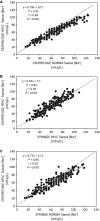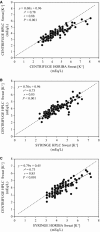Validity and reliability of a field technique for sweat Na+ and K+ analysis during exercise in a hot-humid environment
- PMID: 24793982
- PMCID: PMC4098735
- DOI: 10.14814/phy2.12007
Validity and reliability of a field technique for sweat Na+ and K+ analysis during exercise in a hot-humid environment
Abstract
Abstract This study compared a field versus reference laboratory technique for extracting (syringe vs. centrifuge) and analyzing sweat [Na(+)] and [K(+)] (compact Horiba B-722 and B-731, HORIBA vs. ion chromatography, HPLC) collected with regional absorbent patches during exercise in a hot-humid environment. Sweat samples were collected from seven anatomical sites on 30 athletes during 1-h cycling in a heat chamber (33°C, 67% rh). Ten minutes into exercise, skin was cleaned/dried and two sweat patches were applied per anatomical site. After removal, one patch per site was centrifuged and sweat was analyzed with HORIBA in the heat chamber (CENTRIFUGE HORIBA) versus HPLC (CENTRIFUGE HPLC). Sweat from the second patch per site was extracted using a 5-mL syringe and analyzed with HORIBA in the heat chamber (SYRINGE HORIBA) versus HPLC (SYRINGE HPLC). CENTRIFUGE HORIBA, SYRINGE HPLC, and SYRINGE HORIBA were highly related to CENTRIFUGE HPLC ([Na(+)]: ICC = 0.96, 0.94, and 0.93, respectively; [K(+)]: ICC = 0.87, 0.92, and 0.84, respectively), while mean differences from CENTRIFUGE HPLC were small but usually significant ([Na(+)]: 4.7 ± 7.9 mEql/L, -2.5 ± 9.3 mEq/L, 4.0 ± 10.9 mEq/L (all P < 0.001), respectively; [K(+)]: 0.44 ± 0.52 mEq/L (P < 0.001), 0.01 ± 0.49 mEq/L (P = 0.77), 0.50 ± 0.48 mEq/L (P < 0.001), respectively). On the basis of typical error of the measurement results, sweat [Na(+)] and [K(+)] obtained with SYRINGE HORIBA falls within ±15.4 mEq/L and ±0.68 mEq/L, respectively, of CENTRIFUGE HPLC 95% of the time. The field (SYRINGE HORIBA) method of extracting and analyzing sweat from regional absorbent patches may be useful in obtaining sweat [Na(+)] when rapid estimates in a hot-humid field setting are needed.
Keywords: Compact electrolyte analyzers; Horiba; regional sweat collection; sweat patches.
Figures



Similar articles
-
Validity and reliability of the Horiba C-122 compact sodium analyzer in sweat samples of athletes.Eur J Appl Physiol. 2012 Oct;112(10):3479-85. doi: 10.1007/s00421-012-2331-y. Eur J Appl Physiol. 2012. PMID: 22294293
-
Comparison of regional patch collection vs. whole body washdown for measuring sweat sodium and potassium loss during exercise.J Appl Physiol (1985). 2009 Sep;107(3):887-95. doi: 10.1152/japplphysiol.00197.2009. Epub 2009 Jun 18. J Appl Physiol (1985). 2009. PMID: 19541738
-
Reliability and validity of the MX3 portable sweat sodium analyser during exercise in warm conditions.Eur J Appl Physiol. 2024 Jul;124(7):2153-2160. doi: 10.1007/s00421-024-05447-w. Epub 2024 Mar 2. Eur J Appl Physiol. 2024. PMID: 38430262 Free PMC article.
-
Sweating Rate and Sweat Sodium Concentration in Athletes: A Review of Methodology and Intra/Interindividual Variability.Sports Med. 2017 Mar;47(Suppl 1):111-128. doi: 10.1007/s40279-017-0691-5. Sports Med. 2017. PMID: 28332116 Free PMC article. Review.
-
Sweat testing for cocaine, codeine and metabolites by gas chromatography-mass spectrometry.J Chromatogr B Biomed Sci Appl. 1999 Oct 15;733(1-2):247-64. doi: 10.1016/s0378-4347(99)00246-7. J Chromatogr B Biomed Sci Appl. 1999. PMID: 10572984 Review.
Cited by
-
Physiology of sweat gland function: The roles of sweating and sweat composition in human health.Temperature (Austin). 2019 Jul 17;6(3):211-259. doi: 10.1080/23328940.2019.1632145. eCollection 2019. Temperature (Austin). 2019. PMID: 31608304 Free PMC article. Review.
-
Comprehensive Review on Wearable Sweat-Glucose Sensors for Continuous Glucose Monitoring.Sensors (Basel). 2022 Jan 14;22(2):638. doi: 10.3390/s22020638. Sensors (Basel). 2022. PMID: 35062598 Free PMC article. Review.
-
Sodium Ingestion Improves Groundstroke Performance in Nationally-Ranked Tennis Players: A Randomized, Placebo-Controlled Crossover Trial.Front Nutr. 2020 Sep 22;7:549413. doi: 10.3389/fnut.2020.549413. eCollection 2020. Front Nutr. 2020. PMID: 33072795 Free PMC article.
-
Simultaneous detection of urea and lactate in sweat based on a wearable sweat biosensor.Biomed Opt Express. 2023 Dec 4;15(1):14-27. doi: 10.1364/BOE.505004. eCollection 2024 Jan 1. Biomed Opt Express. 2023. PMID: 38223175 Free PMC article.
-
International Society of Sports Nutrition Position Stand: nutritional considerations for single-stage ultra-marathon training and racing.J Int Soc Sports Nutr. 2019 Nov 7;16(1):50. doi: 10.1186/s12970-019-0312-9. J Int Soc Sports Nutr. 2019. PMID: 31699159 Free PMC article. Review.
References
-
- ACSM. 2008. 129.inDwyer G. B., Davis S. E. (eds.). In: Dwyer G. B., Davis S. E. (eds.). Maximal exercise testing. ACSM's health‐related physical fitness assessment manual Baltimore, MD: Lipincott Williams & Wilkins
-
- Allan J. R., Wilson C. G. 1971. Influence of acclimatization on sweat sodium concentration. J. Appl. Physiol.; 30:708-712 - PubMed
-
- Armstrong L. E., Casa D. J. 2009. Methods to evaluate electrolyte and water turnover of athletes. Athl. Train. Sports Health Care; 1:169-179
-
- Armstrong L. E., Casa D. J., Millard‐Stafford M., Moran D. S., Pyne S. W., Roberts W. O. 2007. American College of Sports Medicine position stand. Exertional heat illness during training and competition. Med. Sci. Sports Exerc.; 39:556-572 - PubMed
-
- Baker L. B., Stofan J. R., Hamilton A. A., Horswill C. A. 2009. Comparison of regional patch collection vs. whole body washdown for measuring sweat sodium and potassium loss during exercise. J. Appl. Physiol.; 107:887-895 - PubMed
LinkOut - more resources
Full Text Sources
Other Literature Sources

